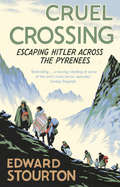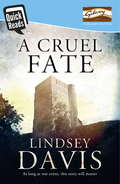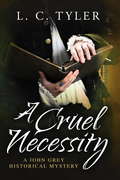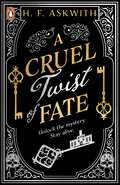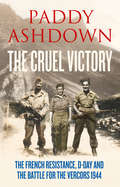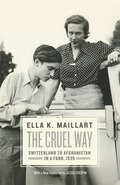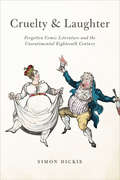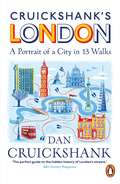- Table View
- List View
A Cruel Courtship: (Margaret Kerr Trilogy: Book 3) (Margaret Kerr Trilogy #3)
by Candace RobbScotland, 1297.Passionate, brave and fiercely loyal, Margaret Kerr - a young woman estranged from her husband - is determined to play her part in saving Scotland from the hammer of Edward Longshanks - King of England and would-be King of the Scots. And so she travels to Stirling to discover why the informer upon whom the Scottish rebels depend has become unreliable. It is an important and difficult mission, for he who holds Stirling Castle holds Scotland, and with fresh English recruits marching forth, a bloody battle for the castle is imminent. As the Scots prepare to cast off the English yoke once and for all, Margaret soon realises she can trust no one, not even her closest friends. Is she prepared to give her life for her country?
Cruel Crossing: Escaping Hitler Across the Pyrenees
by Edward StourtonThe mountain paths are as treacherous as they are steep – the more so in the dark and in winter. Even for the fit the journey is a formidable challenge. Hundreds of those who climbed through the Pyrenees during the Second World War were malnourished and exhausted after weeks on the run hiding in barns and attics. Many never even reached the Spanish border. Today their bravery and endurance is commemorated each July by a trek along the Chemin de la Liberté – the toughest and most dangerous of wartime routes. From his fellow pilgrims Edward Stourton uncovers stories of midnight scrambles across rooftops and drops from speeding trains; burning Lancasters, doomed love affairs, horrific murder and astonishing heroism. The lives of the men, women and children who were drawn by the war to the Pyrenees often read as breathtakingly exciting adventure, but they were led against a background of intense fear, mounting persecution and appalling risk. Drawing on interviews with the few remaining survivors and the families of those who were there, Edward Stourton’s vivid history of this little-known aspect of the Second World War is shocking, dramatic and intensely moving.
A Cruel Fate
by Lindsey DavisMartin Watts, a bookseller, is captured by Royalists. Jane Afton's brother Nat is taken too. They suffer inhumane treatment as prisoners-of-war. In Oxford Castle jailor William Smith tortures, beats, starves and deprives his helpless victims. Can Jane rescue her sick brother before he dies of neglect? Will Martin dare to escape? Based on real events in the English Civil War, Lindsey Davis retells the grim tale of Captain Smith's abuse of power in Oxford prison - where many died in misery though a lucky few survived.
Cruel Habitations: A History of Working-Class Housing, 1780–1918 (Routledge Revivals)
by Enid GauldieCruel Habitations (1974) looks at the pre-industrial background in which housing problems are rooted, with the decay of towns and the unsuccessful attempts to better their condition by public health reforms, by charitable agencies and by building societies – and with legislative action in Parliament towards housing reform.
Cruel Habitations: A History of Working-Class Housing, 1780–1918 (Routledge Revivals)
by Enid GauldieCruel Habitations (1974) looks at the pre-industrial background in which housing problems are rooted, with the decay of towns and the unsuccessful attempts to better their condition by public health reforms, by charitable agencies and by building societies – and with legislative action in Parliament towards housing reform.
A Cruel Necessity (A John Grey Historical Mystery #1)
by L.C. TylerThe first John Grey historical mysteryThe theatres are padlocked. Christmas has been cancelled. It is 1657 and the unloved English Republic is eight years old. Though Cromwell's joyless grip on power appears immovable, many still look to Charles Stuart's dissolute and threadbare court-in-exile, and some are prepared to risk their lives plotting a restoration. For the officers of the Republic, constant vigilance is needed. So, when the bloody corpse of a Royalist spy is discovered on the dung heap of a small Essex village, why is the local magistrate so reluctant to investigate? John Grey, a young lawyer with no clients, finds himself alone in believing that the murdered man deserves justice. Grey is drawn into a vortex of plot and counter-plot and into the all-encompassing web of intrigue spun by Cromwell's own spy-master, John Thurloe. So when nothing is what is seems, can Grey trust anyone?'Tyler juggles his characters, story wit and clever one liners with perfect balance' - The Times'A cracking pace, lively dialogue, wickedly witty one-liners salted with sophistication . . . Why would we not want more of John Grey?' - The Bookbag
The Cruel Streets Revisited: A Case File of Cardiff's Lawless Past, its Growth, its Characters, its Murders, and its Mean Streets (Wordcatcher History)
by John F. WakeCARDIFF'S MEAN STREETS REVEALED. In this book we look at a side of Cardiff’s history that wasn’t wholesome, yet it reflects the times - the struggles and poverty. Many people today have a romantic or nostalgic view of their city’s past. They imagine the old back streets populated by rough-and- ready ‘Jack The Lads’ and Robin Hood-style characters, They imagine that, while times were hard, people were poor but generally happy. Think again. The historical voices of law and order give a different perspective to history. But this book isn’t written from the viewpoint of the governing classes or in the wider terms of national economics or social commentary. Instead,it portrays the realities of pounding the beat, often alone, in streets that were populated by those without financial advantages, education, or opportunities for upward mobility. Fuelled by alcohol, desperation, and poverty, the people who came into contact with the law had day-to-day struggles that most of us can barely imagine. The social deprivation, the inequalities of class, gender, race, and age, these were the factors that led many to crime as a means of daily survival. This book tells the story of some of the real characters, sometimes merely nameless records in police files or newspapers. Others that we follow were better documented. This is a collection of reports that bring to life the meaner aspects of Cardiff’s back streets. Temperancetown, Tiger Bay, Butetown - all names that, for some, conjure up pictures of complete lawlessness. How did that happen? How did these small areas of a large city attract such a reputation? This book is compiled from extensive research in public archives, from conversations with local people, and from the personal experience of a police officer who worked in Cardiff for over 25 years. John Wake offers us snippets of news, and fuller stories, that paint a picture of Cardiff’s history as lived by its poorest and most vulnerable citizens.
The Cruel Streets Revisited: A Case File of Cardiff's Lawless Past, its Growth, its Characters, its Murders, and its Mean Streets (Wordcatcher History)
by John F. WakeCARDIFF'S MEAN STREETS REVEALED. In this book we look at a side of Cardiff’s history that wasn’t wholesome, yet it reflects the times - the struggles and poverty. Many people today have a romantic or nostalgic view of their city’s past. They imagine the old back streets populated by rough-and- ready ‘Jack The Lads’ and Robin Hood-style characters, They imagine that, while times were hard, people were poor but generally happy. Think again. The historical voices of law and order give a different perspective to history. But this book isn’t written from the viewpoint of the governing classes or in the wider terms of national economics or social commentary. Instead,it portrays the realities of pounding the beat, often alone, in streets that were populated by those without financial advantages, education, or opportunities for upward mobility. Fuelled by alcohol, desperation, and poverty, the people who came into contact with the law had day-to-day struggles that most of us can barely imagine. The social deprivation, the inequalities of class, gender, race, and age, these were the factors that led many to crime as a means of daily survival. This book tells the story of some of the real characters, sometimes merely nameless records in police files or newspapers. Others that we follow were better documented. This is a collection of reports that bring to life the meaner aspects of Cardiff’s back streets. Temperancetown, Tiger Bay, Butetown - all names that, for some, conjure up pictures of complete lawlessness. How did that happen? How did these small areas of a large city attract such a reputation? This book is compiled from extensive research in public archives, from conversations with local people, and from the personal experience of a police officer who worked in Cardiff for over 25 years. John Wake offers us snippets of news, and fuller stories, that paint a picture of Cardiff’s history as lived by its poorest and most vulnerable citizens.
A Cruel Twist of Fate
by H. F. AskwithAnd Then There Were None meets The Inheritance Games, with a heavy dash of The Woman in Black, in this gloriously gothic YA mystery-thriller.When eighteen-year-old Helena is sent to be a governess at Archfall Manor - a beautiful but crumbling manor house, perched at the edge of a causeway in the North Sea - she feels confident she will know how to deal with the esteemed but eccentric Cauldwell family who own it. But it quickly becomes clear that the Cauldwells are hiding more than Helena could ever have dreamed of.A series of sinister events come to a head with a gruesome death - swiftly followed by another. Worse still, with the path back to the mainland cut off by a terrible storm, and no way to get help, suspicions and paranoia quickly run rampant.But the Cauldwells aren't the only ones keeping secrets. Helena has some very important ones of her own - and soon she begins to wonder whether dark powers beyond her control might be forcing her to twist the fate of the family - and her own destiny - forever.Praise for A Dark Inheritance: "A powerful, heart-racing story of family, fate, and writing your own destiny. Intricately plotted and luminously written - I loved it" Laura Steven, author of The Society for Soulless Girls
The Cruel Victory: The French Resistance And The Battle For The Vercors 1944
by Paddy AshdownFrom the bestselling and prize-winning author of ‘A Brilliant Little Operation’ comes the long neglected D-Day story of the largest action by the French Resistance during WWII, published to coincide with the 70th anniversary of the Normandy landings.
The Cruel Way: Switzerland to Afghanistan in a Ford, 1939
by Ella K. MaillartIn 1939 Swiss travel writer and journalist Ella K. Maillart set off on an epic journey from Geneva to Kabul with fellow writer Annemarie Schwarzenbach in a brand new Ford. As the first European women to travel alone on Afghanistan’s Northern Road, Maillart and Schwarzenbach had a rare glimpse of life in Iran and Afghanistan at a time when their borders were rarely crossed by Westerners. As the two flash across Europe and the Near East in a streak of élan and daring, Maillart writes of comical mishaps, breathtaking landscapes, vitriolic religious clashes, and the ingenuity with which the women navigated what was often a dangerous journey. In beautiful, clear-eyed prose, The Cruel Way shows Maillart’s great ability to explore and experience other cultures in writing both lyrical and deeply empathetic. While the core of the book is the journey itself and their interactions with people oppressed by political conflict and poverty, towards the end of the trip the women’s increasingly troubled relationship takes center stage. By then the glamorous, androgynous Schwarzenbach, whose own account of the trip can be found in All the Roads Are Open, is fighting a losing battle with her own drug addiction, and Maillart’s frustrated attempts to cure her show the profound depth of their relationship. Complete with thirteen of Maillart’s own photographs from the journey, The Cruel Way is a classic of travel writing, and its protagonists are as gripping and fearless as any in literature.
The Cruel Way: Switzerland to Afghanistan in a Ford, 1939
by Ella K. MaillartIn 1939 Swiss travel writer and journalist Ella K. Maillart set off on an epic journey from Geneva to Kabul with fellow writer Annemarie Schwarzenbach in a brand new Ford. As the first European women to travel alone on Afghanistan’s Northern Road, Maillart and Schwarzenbach had a rare glimpse of life in Iran and Afghanistan at a time when their borders were rarely crossed by Westerners. As the two flash across Europe and the Near East in a streak of élan and daring, Maillart writes of comical mishaps, breathtaking landscapes, vitriolic religious clashes, and the ingenuity with which the women navigated what was often a dangerous journey. In beautiful, clear-eyed prose, The Cruel Way shows Maillart’s great ability to explore and experience other cultures in writing both lyrical and deeply empathetic. While the core of the book is the journey itself and their interactions with people oppressed by political conflict and poverty, towards the end of the trip the women’s increasingly troubled relationship takes center stage. By then the glamorous, androgynous Schwarzenbach, whose own account of the trip can be found in All the Roads Are Open, is fighting a losing battle with her own drug addiction, and Maillart’s frustrated attempts to cure her show the profound depth of their relationship. Complete with thirteen of Maillart’s own photographs from the journey, The Cruel Way is a classic of travel writing, and its protagonists are as gripping and fearless as any in literature.
The Cruel Way: Switzerland to Afghanistan in a Ford, 1939
by Ella K. MaillartIn 1939 Swiss travel writer and journalist Ella K. Maillart set off on an epic journey from Geneva to Kabul with fellow writer Annemarie Schwarzenbach in a brand new Ford. As the first European women to travel alone on Afghanistan’s Northern Road, Maillart and Schwarzenbach had a rare glimpse of life in Iran and Afghanistan at a time when their borders were rarely crossed by Westerners. As the two flash across Europe and the Near East in a streak of élan and daring, Maillart writes of comical mishaps, breathtaking landscapes, vitriolic religious clashes, and the ingenuity with which the women navigated what was often a dangerous journey. In beautiful, clear-eyed prose, The Cruel Way shows Maillart’s great ability to explore and experience other cultures in writing both lyrical and deeply empathetic. While the core of the book is the journey itself and their interactions with people oppressed by political conflict and poverty, towards the end of the trip the women’s increasingly troubled relationship takes center stage. By then the glamorous, androgynous Schwarzenbach, whose own account of the trip can be found in All the Roads Are Open, is fighting a losing battle with her own drug addiction, and Maillart’s frustrated attempts to cure her show the profound depth of their relationship. Complete with thirteen of Maillart’s own photographs from the journey, The Cruel Way is a classic of travel writing, and its protagonists are as gripping and fearless as any in literature.
The Cruel Way: Switzerland to Afghanistan in a Ford, 1939
by Ella K. MaillartIn 1939 Swiss travel writer and journalist Ella K. Maillart set off on an epic journey from Geneva to Kabul with fellow writer Annemarie Schwarzenbach in a brand new Ford. As the first European women to travel alone on Afghanistan’s Northern Road, Maillart and Schwarzenbach had a rare glimpse of life in Iran and Afghanistan at a time when their borders were rarely crossed by Westerners. As the two flash across Europe and the Near East in a streak of élan and daring, Maillart writes of comical mishaps, breathtaking landscapes, vitriolic religious clashes, and the ingenuity with which the women navigated what was often a dangerous journey. In beautiful, clear-eyed prose, The Cruel Way shows Maillart’s great ability to explore and experience other cultures in writing both lyrical and deeply empathetic. While the core of the book is the journey itself and their interactions with people oppressed by political conflict and poverty, towards the end of the trip the women’s increasingly troubled relationship takes center stage. By then the glamorous, androgynous Schwarzenbach, whose own account of the trip can be found in All the Roads Are Open, is fighting a losing battle with her own drug addiction, and Maillart’s frustrated attempts to cure her show the profound depth of their relationship. Complete with thirteen of Maillart’s own photographs from the journey, The Cruel Way is a classic of travel writing, and its protagonists are as gripping and fearless as any in literature.
Cruelty and Civilization: The Roman Games
by Roland AuguetRoland Auguet examines the Roman taste for blood and considers what the games, that strange combination of Cruelty and Civilization, reveal about the Roman mentality. He shows how the great spectacles became a part of city life - they were awaited with impatience, everyone discussed them, some applauded the action in the arena, while others booed frantically.This book provides an exciting history of gladiators, chariot racing and other games as well as an investigation of their function and significance within society. It is essential reading for anyone who is interested in the Romans' violent form of entertainment.
Cruelty and Civilization: The Roman Games
by Roland AuguetRoland Auguet examines the Roman taste for blood and considers what the games, that strange combination of Cruelty and Civilization, reveal about the Roman mentality. He shows how the great spectacles became a part of city life - they were awaited with impatience, everyone discussed them, some applauded the action in the arena, while others booed frantically.This book provides an exciting history of gladiators, chariot racing and other games as well as an investigation of their function and significance within society. It is essential reading for anyone who is interested in the Romans' violent form of entertainment.
Cruelty and Companionship: Conflict in Nineteenth Century Married Life
by A. James HammertonCruelty and Companionship is an account of the intimate but darker sides of marriage in Victorian and Edwardian England. Hammerton draws upon previously unpublished material from the records of the divorce court and magistrates' courts to challenge many popular views about changing family patterns. His findings open a rare window onto the sexual politics of everyday life and the routine tensions which conditioned marriage in middle and working class families. Using contemporary evidence ranging from prescriptive texts and public debate to autobiography and fiction, Hammerton examines the intense public scrutiny which accompanied the routine exposure of marital breakdown, and charts a growing critique of men's behaviour in marriage which increasingly demanded regulation and reform. The critical discourse which resulted, ranging from paternalist to feminist, casts new light on the origins and trajectory of nineteenth century feminism, legal change and our understanding of the changing expression of masculinity.
Cruelty and Companionship: Conflict in Nineteenth Century Married Life
by A. James HammertonCruelty and Companionship is an account of the intimate but darker sides of marriage in Victorian and Edwardian England. Hammerton draws upon previously unpublished material from the records of the divorce court and magistrates' courts to challenge many popular views about changing family patterns. His findings open a rare window onto the sexual politics of everyday life and the routine tensions which conditioned marriage in middle and working class families. Using contemporary evidence ranging from prescriptive texts and public debate to autobiography and fiction, Hammerton examines the intense public scrutiny which accompanied the routine exposure of marital breakdown, and charts a growing critique of men's behaviour in marriage which increasingly demanded regulation and reform. The critical discourse which resulted, ranging from paternalist to feminist, casts new light on the origins and trajectory of nineteenth century feminism, legal change and our understanding of the changing expression of masculinity.
Cruelty and Laughter: Forgotten Comic Literature and the Unsentimental Eighteenth Century
by Simon DickieEighteenth-century British culture is often seen as polite and sentimental—the creation of an emerging middle class. Simon Dickie disputes these assumptions in Cruelty and Laughter, a wildly enjoyable but shocking plunge into the forgotten comic literature of the age. Beneath the surface of Enlightenment civility, Dickie uncovers a rich vein of cruel humor that forces us to recognize just how slowly ordinary human sufferings became worthy of sympathy. Delving into an enormous archive of comic novels, jestbooks, farces, variety shows, and cartoons, Dickie finds a vast repository of jokes about cripples, blind men, rape, and wife-beating. Epigrams about syphilis and scurvy sit alongside one-act comedies about hunchbacks in love. He shows us that everyone—rich and poor, women as well as men—laughed along. In the process, Dickie also expands our understanding of many of the century’s major authors, including Samuel Richardson, Lady Mary Wortley Montagu, Tobias Smollett, Frances Burney, and Jane Austen. He devotes particular attention to Henry Fielding’s Joseph Andrews, a novel that reflects repeatedly on the limits of compassion and the ethical problems of laughter. Cruelty and Laughter is an engaging, far-reaching study of the other side of culture in eighteenth-century Britain.
Cruelty and Laughter: Forgotten Comic Literature and the Unsentimental Eighteenth Century
by Simon DickieEighteenth-century British culture is often seen as polite and sentimental—the creation of an emerging middle class. Simon Dickie disputes these assumptions in Cruelty and Laughter, a wildly enjoyable but shocking plunge into the forgotten comic literature of the age. Beneath the surface of Enlightenment civility, Dickie uncovers a rich vein of cruel humor that forces us to recognize just how slowly ordinary human sufferings became worthy of sympathy. Delving into an enormous archive of comic novels, jestbooks, farces, variety shows, and cartoons, Dickie finds a vast repository of jokes about cripples, blind men, rape, and wife-beating. Epigrams about syphilis and scurvy sit alongside one-act comedies about hunchbacks in love. He shows us that everyone—rich and poor, women as well as men—laughed along. In the process, Dickie also expands our understanding of many of the century’s major authors, including Samuel Richardson, Lady Mary Wortley Montagu, Tobias Smollett, Frances Burney, and Jane Austen. He devotes particular attention to Henry Fielding’s Joseph Andrews, a novel that reflects repeatedly on the limits of compassion and the ethical problems of laughter. Cruelty and Laughter is an engaging, far-reaching study of the other side of culture in eighteenth-century Britain.
Cruelty and Laughter: Forgotten Comic Literature and the Unsentimental Eighteenth Century
by Simon DickieEighteenth-century British culture is often seen as polite and sentimental—the creation of an emerging middle class. Simon Dickie disputes these assumptions in Cruelty and Laughter, a wildly enjoyable but shocking plunge into the forgotten comic literature of the age. Beneath the surface of Enlightenment civility, Dickie uncovers a rich vein of cruel humor that forces us to recognize just how slowly ordinary human sufferings became worthy of sympathy. Delving into an enormous archive of comic novels, jestbooks, farces, variety shows, and cartoons, Dickie finds a vast repository of jokes about cripples, blind men, rape, and wife-beating. Epigrams about syphilis and scurvy sit alongside one-act comedies about hunchbacks in love. He shows us that everyone—rich and poor, women as well as men—laughed along. In the process, Dickie also expands our understanding of many of the century’s major authors, including Samuel Richardson, Lady Mary Wortley Montagu, Tobias Smollett, Frances Burney, and Jane Austen. He devotes particular attention to Henry Fielding’s Joseph Andrews, a novel that reflects repeatedly on the limits of compassion and the ethical problems of laughter. Cruelty and Laughter is an engaging, far-reaching study of the other side of culture in eighteenth-century Britain.
Cruelty and Laughter: Forgotten Comic Literature and the Unsentimental Eighteenth Century
by Simon DickieEighteenth-century British culture is often seen as polite and sentimental—the creation of an emerging middle class. Simon Dickie disputes these assumptions in Cruelty and Laughter, a wildly enjoyable but shocking plunge into the forgotten comic literature of the age. Beneath the surface of Enlightenment civility, Dickie uncovers a rich vein of cruel humor that forces us to recognize just how slowly ordinary human sufferings became worthy of sympathy. Delving into an enormous archive of comic novels, jestbooks, farces, variety shows, and cartoons, Dickie finds a vast repository of jokes about cripples, blind men, rape, and wife-beating. Epigrams about syphilis and scurvy sit alongside one-act comedies about hunchbacks in love. He shows us that everyone—rich and poor, women as well as men—laughed along. In the process, Dickie also expands our understanding of many of the century’s major authors, including Samuel Richardson, Lady Mary Wortley Montagu, Tobias Smollett, Frances Burney, and Jane Austen. He devotes particular attention to Henry Fielding’s Joseph Andrews, a novel that reflects repeatedly on the limits of compassion and the ethical problems of laughter. Cruelty and Laughter is an engaging, far-reaching study of the other side of culture in eighteenth-century Britain.
Cruelty and Laughter: Forgotten Comic Literature and the Unsentimental Eighteenth Century
by Simon DickieEighteenth-century British culture is often seen as polite and sentimental—the creation of an emerging middle class. Simon Dickie disputes these assumptions in Cruelty and Laughter, a wildly enjoyable but shocking plunge into the forgotten comic literature of the age. Beneath the surface of Enlightenment civility, Dickie uncovers a rich vein of cruel humor that forces us to recognize just how slowly ordinary human sufferings became worthy of sympathy. Delving into an enormous archive of comic novels, jestbooks, farces, variety shows, and cartoons, Dickie finds a vast repository of jokes about cripples, blind men, rape, and wife-beating. Epigrams about syphilis and scurvy sit alongside one-act comedies about hunchbacks in love. He shows us that everyone—rich and poor, women as well as men—laughed along. In the process, Dickie also expands our understanding of many of the century’s major authors, including Samuel Richardson, Lady Mary Wortley Montagu, Tobias Smollett, Frances Burney, and Jane Austen. He devotes particular attention to Henry Fielding’s Joseph Andrews, a novel that reflects repeatedly on the limits of compassion and the ethical problems of laughter. Cruelty and Laughter is an engaging, far-reaching study of the other side of culture in eighteenth-century Britain.
Cruelty and Laughter: Forgotten Comic Literature and the Unsentimental Eighteenth Century
by Simon DickieEighteenth-century British culture is often seen as polite and sentimental—the creation of an emerging middle class. Simon Dickie disputes these assumptions in Cruelty and Laughter, a wildly enjoyable but shocking plunge into the forgotten comic literature of the age. Beneath the surface of Enlightenment civility, Dickie uncovers a rich vein of cruel humor that forces us to recognize just how slowly ordinary human sufferings became worthy of sympathy. Delving into an enormous archive of comic novels, jestbooks, farces, variety shows, and cartoons, Dickie finds a vast repository of jokes about cripples, blind men, rape, and wife-beating. Epigrams about syphilis and scurvy sit alongside one-act comedies about hunchbacks in love. He shows us that everyone—rich and poor, women as well as men—laughed along. In the process, Dickie also expands our understanding of many of the century’s major authors, including Samuel Richardson, Lady Mary Wortley Montagu, Tobias Smollett, Frances Burney, and Jane Austen. He devotes particular attention to Henry Fielding’s Joseph Andrews, a novel that reflects repeatedly on the limits of compassion and the ethical problems of laughter. Cruelty and Laughter is an engaging, far-reaching study of the other side of culture in eighteenth-century Britain.
Cruickshank’s London: A Portrait Of A City In 20 Walks
by Dan CruickshankLondon. City of ancient churches and bustling markets, palatial townhouses and modest terraces, two millennia of expansion, commerce and street life. This is its story.In Cruickshank’s London, Britain’s favourite architectural historian offers a tour through thirteen districts that made London into London. From the mysterious Anglo-Saxon roots of Hampstead Heath, via Christopher Wren’s magisterial City churches, to the industrial bustle of Victorian Bermondsey, each of his walks explores a crucial site in our capital’s history – and reveals how it forged the modern capital.Jumping between East Ham in the east and Kew in the west, Dan Cruickshank explores both world-famous buildings (the Tower of London and St Pancras Station) and oft-overlooked local landmarks (Dagenham Civic Centre and Kensal Green Cemetery). His tales reveal not only the most important moments in London’s history, but also the forgotten characters who witnessed them: the Huguenot weavers who transformed Spitalfields into a vibrant enclave of Georgian London, the visionary architects behind the likes of Somerset House and the Houses of Parliament, and the streetwalkers who once thronged London’s great sexual highway. Along the way, he peppers the book with beautiful photographs, historical sketches and handy maps, so you can immediately follow in his footsteps.Above all, Cruickshank calls on you to explore London. Every street in the city contains a story. This book invites you to hear them.

